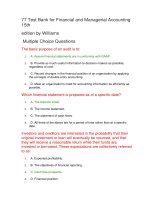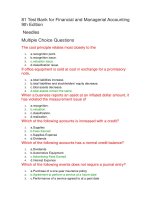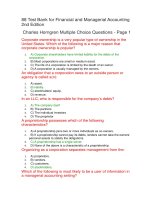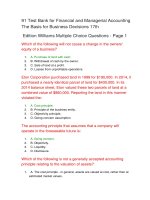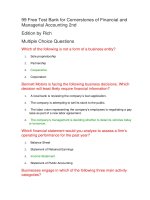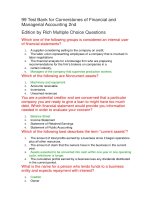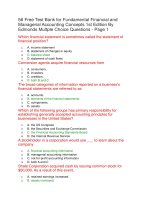TEST BANK financial and managerial accounting 9e by warch27(12) cost management for just in time environments
Bạn đang xem bản rút gọn của tài liệu. Xem và tải ngay bản đầy đủ của tài liệu tại đây (132.85 KB, 26 trang )
Chapter 27(12)
Cost Management for Just-In-Time Environments
OBJECTIVES
Obj 1
Obj 2
Obj 3
Obj 4
Obj 5
Compare and contrast just-in-time (JIT) manufacturing practices with traditional
manufacturing practices.
Apply just-in-time manufacturing practices to a traditional manufacturing
illustration.
Describe the implications of a just-in-time manufacturing philosophy on cost
accounting and performance measurement systems.
Apply just-in-time practices to a non-manufacturing setting.
Describe and illustrate activity analysis for improving operations.
QUESTION GRID
True / False
OD OD
2 E 2 E
2 E 2 E
2 E 2 E
2 E 2 E
2 E 2 E
2 E 2 E
2 E 2 E
2 E 2 E
2 E 2 E
2 E 2 E
2 E 2 E
2 E 2 E
2 E 2 E
2 E 2 E
2 E 2 E
2 E 2 E
2 E 2 E
2 E 2 E
2 E 2 E
2 E 2 E
2 E 2 M
2 E 2 E
Matching
OD
2 E
2 E
2 E
2 E
2 E
2 E
2 E
2 E
2 D
2 D
2 D
2 D
2 M
2 M
2 M
2 E
2 E
2 E
2 M
2 D
No.
1
2
3
4
5
6
Objective
27(12)-05
27(12)-05
27(12)-05
27(12)-05
27(12)-05
27(12)-05
1
2 ✦ Chapter 27(12)/Cost Management for Just-In-Time Environments
Multiple Choice
No.
Objective
1
2
3
4
5
6
7
8
9
10
11
12
13
14
15
16
17
27(12)-01
27(12)-01
27(12)-01
27(12)-01
27(12)-01
27(12)-01
27(12)-01
27(12)-01
27(12)-01
27(12)-01
27(12)-01
27(12)-01
27(12)-01
27(12)-01
27(12)-01
27(12)-01
27(12)-02
Exercise/Other
No. Objectiv
e
1
27(12)01
2
27(12)02
Problem
N Obj
o ecti
. ve
1 27(
12)01
2 27(
12)03
3 27(
12)03
4 27(
12)03
Diff
icul
ty
Mo
der
ate
Mo
der
ate
Diff
icul
t
Eas
y
Difficult
y
Moderate
No.
Objective
3
27(12)-03
Difficult
y
Difficult
Easy
4
27(12)-05
Moderate
N Obje
o ctive
.
5 27(1
2)-03
6 27(1
2)-04
7 27(1
2)-04
8 27(1
2)-04
Diff
icul
ty
Mo
der
ate
Mo
der
ate
Mo
der
ate
Mo
der
ate
N
o
.
9
Obj
ecti
ve
27(
12)04
1 27(
0 12)04
Diff
icul
ty
Mo
dera
te
Mo
dera
te
No.
Objective
5
27(12)-05
Difficult
y
Moderate
Chapter 27(12)/Cost Management for Just-In-Time Environments ✦ 3
Chapter 27(12)—Cost Management for Just-In-Time Environments
TRUE/FALSE
1. Just-in-Time (JIT) manufacturing focuses on reducing time, cost, and poor quality in processes.
ANS: T
DIF: Easy OBJ: 27(12)-01
NAT: AACSB Analytic | IMA-Cost Management
2.
The just-in-time (JIT) philosophy views inventory as a necessary buffer to protect against process
problems.
ANS: F
DIF: Easy OBJ: 27(12)-01
NAT: AACSB Analytic | IMA-Cost Management
3. The just-in-time (JIT) philosophy views inventory as an unnecessary waste of resources.
ANS: T
DIF: Easy OBJ: 27(12)-01
NAT: AACSB Analytic | IMA-Cost Management
4. In the just-in-time (JIT) philosophy, unexpected downtime is the result of unreliable processes.
ANS: T
DIF: Easy OBJ: 27(12)-01
NAT: AACSB Analytic | IMA-Cost Management
5. Lead time is the process time between start and completion.
ANS: T
DIF: Easy OBJ: 27(12)-01
NAT: AACSB Analytic | IMA-Cost Management
6. Lead time is value-added time.
ANS: F
DIF: Easy OBJ: 27(12)-01
NAT: AACSB Analytic | IMA-Cost Management
7. Lead time includes both value-added time and nonvalue-added time.
ANS: T
DIF: Easy OBJ: 27(12)-01
NAT: AACSB Analytic | IMA-Cost Management
8. Lead time reduction can be a cost-saving goal for any processed item.
ANS: T
DIF: Easy OBJ: 27(12)-01
NAT: AACSB Analytic | IMA-Cost Management
9. Nonvalue-added activities are performed only because of process ineffectiveness.
ANS: T
DIF: Easy OBJ: 27(12)-01
NAT: AACSB Analytic | IMA-Cost Management
10. Reducing wait time is not linked to reducing inventory.
ANS: F
DIF: Easy OBJ: 27(12)-01
NAT: AACSB Analytic | IMA-Cost Management
11. Reducing wait time is directly linked to reducing inventory.
ANS: T
DIF: Easy OBJ: 27(12)-01
NAT: AACSB Analytic | IMA-Cost Management
4 ✦ Chapter 27(12)/Cost Management for Just-In-Time Environments
12. Just-in-Time (JIT) manufacturing favors organizing work around products rather than around
processes.
ANS: T
DIF: Easy OBJ: 27(12)-01
NAT: AACSB Analytic | IMA-Cost Management
13. Just-in-Time (JIT) manufacturing favors organizing work around processes rather than around
products.
ANS: F
DIF: Easy OBJ: 27(12)-01
NAT: AACSB Analytic | IMA-Cost Management
14. Employee involvement in a product-oriented factory emphasizes employee teams, rather than
individual employees.
ANS: T
DIF: Easy OBJ: 27(12)-01
NAT: AACSB Analytic | IMA-Cost Management
15. A setup is the time required to prepare an operation for a new production run.
ANS: T
DIF: Easy OBJ: 27(12)-01
NAT: AACSB Analytic | IMA-Cost Management
16. Long setups and large batch sizes result in smaller inventories.
ANS: F
DIF: Easy OBJ: 27(12)-01
NAT: AACSB Analytic | IMA-Cost Management
17. Within-batch wait time increases total lead time.
ANS: T
DIF: Easy OBJ: 27(12)-01
NAT: AACSB Analytic | IMA-Cost Management
18. Large batch sizes increase lead time.
ANS: T
DIF: Easy OBJ: 27(12)-01
NAT: AACSB Analytic | IMA-Cost Management
19. Just-in-Time (JIT) manufacturing is also called make-to-stock manufacturing.
ANS: F
DIF: Easy OBJ: 27(12)-01
NAT: AACSB Analytic | IMA-Cost Management
20. Just-in-Time (JIT) manufacturing is also called make-to-order manufacturing.
ANS: T
DIF: Easy OBJ: 27(12)-01
NAT: AACSB Analytic | IMA-Cost Management
21. A make-to-order company matches its production schedules to actual customer orders.
ANS: T
DIF: Easy OBJ: 27(12)-01
NAT: AACSB Analytic | IMA-Cost Management
22. Make-to-order companies must produce in large batch sizes.
ANS: F
DIF: Easy OBJ: 27(12)-01
NAT: AACSB Analytic | IMA-Cost Management
23. Make-to-order companies typically produce in small batch sizes.
ANS: T
DIF: Easy OBJ: 27(12)-01
NAT: AACSB Analytic | IMA-Cost Management
Chapter 27(12)/Cost Management for Just-In-Time Environments ✦ 5
24. Maximum effectiveness and efficiency are reached when the just-in-time (JIT) philosophy is used
only by manufacturers.
ANS: F
DIF: Easy OBJ: 27(12)-01
NAT: AACSB Analytic | IMA-Cost Management
25. Maximum effectiveness and efficiency are reached when the just-in-time (JIT) philosophy is used by
both manufacturers and their suppliers.
ANS: T
DIF: Easy OBJ: 27(12)-01
NAT: AACSB Analytic | IMA-Cost Management
26. A process-oriented layout segments production facilities into functional departments.
ANS: T
DIF: Easy OBJ: 27(12)-01
NAT: AACSB Analytic | IMA-Cost Management
27. In a push manufacturing system, raw materials are released to production based on forecasted
demand.
ANS: T
DIF: Easy OBJ: 27(12)-01
NAT: AACSB Analytic | IMA-Cost Management
28. In a push manufacturing system, raw materials are released to production based on actual customer
orders.
ANS: F
DIF: Easy OBJ: 27(12)-01
NAT: AACSB Analytic | IMA-Cost Management
29. In a pull manufacturing system, raw materials are released to production based on actual customer
orders.
ANS: T
DIF: Easy OBJ: 27(12)-01
NAT: AACSB Analytic | IMA-Cost Management
30. In a pull manufacturing system, raw materials are released to production based on forecasted
demand.
ANS: F
DIF: Easy OBJ: 27(12)-01
NAT: AACSB Analytic | IMA-Cost Management
31. Setups are a significant time-consuming activity in traditional production environments.
ANS: T
DIF: Easy OBJ: 27(12)-01
NAT: AACSB Analytic | IMA-Cost Management
32. In a just-in-time (JIT) environment, raw materials are delivered less frequently than in a traditional
environment.
ANS: F
DIF: Easy OBJ: 27(12)-01
NAT: AACSB Analytic | IMA-Cost Management
33. In a just-in-time (JIT) environment, raw materials are delivered more frequently than in a traditional
environment.
ANS: T
DIF: Easy OBJ: 27(12)-01
NAT: AACSB Analytic | IMA-Cost Management
6 ✦ Chapter 27(12)/Cost Management for Just-In-Time Environments
34. In a just-in-time (JIT) environment, process problems are more visible than they are in a traditional
environment.
ANS: T
DIF: Easy OBJ: 27(12)-01
NAT: AACSB Analytic | IMA-Cost Management
35. Under the Just-In-Time production concept, employees are better utilized if they are experts in one
operation rather than wasting time training them to learn various production operations.
ANS: F
DIF: Easy OBJ: 27(12)-01
NAT: AACSB Analytic | IMA-Cost Management
36. One inherent risk to using Just-In-Time philosophy is that companies are at higher risk of inventory
shortage during volatile times such as strikes, weather, etc. than the traditional philosophy.
ANS: T
DIF: Easy OBJ: 27(12)-01
NAT: AACSB Analytic | IMA-Cost Management
37. In a just-in-time (JIT) environment, process problems are less visible than they are in a traditional
environment.
ANS: F
DIF: Easy OBJ: 27(12)-01
NAT: AACSB Analytic | IMA-Cost Management
38. Employee involvement does not include performing any indirect manufacturing functions.
ANS: F
DIF: Easy OBJ: 27(12)-01
NAT: AACSB Analytic | IMA-Cost Management
39. Push manufacturing is also referred to as make to order processing.
ANS: F
DIF: Easy OBJ: 27(12)-01
NAT: AACSB Analytic | IMA-Cost Management
40. Push Manufacturing (made to stock) is a traditional approach to manufacturing.
ANS: T
DIF: Easy OBJ: 27(12)-01
NAT: AACSB Analytic | IMA-Cost Management
41. In a just-in-time (JIT) environment, operations only respond to customer orders.
ANS: T
DIF: Easy OBJ: 27(12)-02
NAT: AACSB Analytic | IMA-Cost Management
42. An advantage of using a just-in-time process is a reduction in set-up costs.
ANS: T
DIF: Easy OBJ: 27(12)-02
NAT: AACSB Analytic | IMA-Cost Management
43. In a just-in-time (JIT) system, the work in process and raw materials inventory accounts are
combined.
ANS: T
DIF: Moderate
OBJ: 27(12)-03
NAT: AACSB Analytic | IMA-Cost Management
44. In a just-in-time (JIT) system, the work in process account will show more transactions than in a
traditional cost system.
ANS: F
DIF: Easy OBJ: 27(12)-03
NAT: AACSB Analytic | IMA-Cost Management
Chapter 27(12)/Cost Management for Just-In-Time Environments ✦ 7
45. In a just-in-time (JIT) system, the work in process account will show fewer transactions than in a
traditional cost system.
ANS: T
DIF: Easy OBJ: 27(12)-03
NAT: AACSB Analytic | IMA-Cost Management
46. In a just-in-time (JIT) system, direct labor is eliminated as a separate cost category.
ANS: T
DIF: Easy OBJ: 27(12)-03
NAT: AACSB Analytic | IMA-Cost Management
47. In a just-in-time (JIT) system, indirect labor is traced directly to products.
ANS: T
DIF: Easy OBJ: 27(12)-03
NAT: AACSB Analytic | IMA-Cost Management
48. A traditional cost system uses work in process inventories as control points between each process
step.
ANS: T
DIF: Easy OBJ: 27(12)-03
NAT: AACSB Analytic | IMA-Cost Management
49. In a just-in-time (JIT) system, conversion costs are accumulated at the standard cost of good units
produced.
ANS: T
DIF: Easy OBJ: 27(12)-03
NAT: AACSB Analytic | IMA-Cost Management
50. Financial accounting information is better suited for long-term, operational performance summaries
than is nonfinancial information.
ANS: T
DIF: Easy OBJ: 27(12)-03
NAT: AACSB Analytic | IMA-Cost Management
51. Nonfinancial information is better suited for long-term, operational performance summaries than is
financial accounting information.
ANS: F
DIF: Easy OBJ: 27(12)-03
NAT: AACSB Analytic | IMA-Cost Management
52. A nonfinancial measure is operating information that has not been translated into dollars.
ANS: T
DIF: Easy OBJ: 27(12)-03
NAT: AACSB Analytic | IMA-Cost Management
53. In a just-in-time (JIT) environment, the journal entry to record raw materials purchases would
include a debit to the raw materials inventory account.
ANS: F
DIF: Difficult
OBJ: 27(12)-03
NAT: AACSB Analytic | IMA-Cost Management
54. In a just-in-time (JIT) environment, the journal entry to record raw materials purchases would
include a debit to the raw and in process inventory account.
ANS: T
DIF: Difficult
OBJ: 27(12)-03
NAT: AACSB Analytic | IMA-Cost Management
8 ✦ Chapter 27(12)/Cost Management for Just-In-Time Environments
55. In a just-in-time (JIT) environment, the journal entry to record conversion costs would include a
debit to the raw and in process inventory account.
ANS: T
DIF: Difficult
OBJ: 27(12)-03
NAT: AACSB Analytic | IMA-Cost Management
56. In a just-in-time (JIT) environment, the journal entry to record conversion costs would include a
debit to the manufacturing overhead control account.
ANS: F
DIF: Difficult
OBJ: 27(12)-03
NAT: AACSB Analytic | IMA-Cost Management
57. The budgeted cell conversion cost rate is very similar to the predetermined factory rate in that it only
includes factory overhead costs.
ANS: F
DIF: Moderate
OBJ: 27(12)-03
NAT: AACSB Analytic | IMA-Cost Management
58. A just-in-time nonmanufacturing process can be accomplished by consolidating, in one area, all of
the services provided to a customer.
ANS: T
DIF: Moderate
OBJ: 27(12)-04
NAT: AACSB Analytic | IMA-Cost Management
59. An example of a just-in-time nonmanufacturing principle would be to buy new equipment with the
intention of increasing services to customers.
ANS: F
DIF: Moderate
OBJ: 27(12)-04
NAT: AACSB Analytic | IMA-Cost Management
60. Costs of controlling quality include prevention costs and internal failure costs.
ANS: F
DIF: Easy OBJ: 27(12)-05
NAT: AACSB Analytic | IMA-Cost Management
61. Prevention costs and appraisal costs are considered costs of controlling quality.
ANS: T
DIF: Easy OBJ: 27(12)-05
NAT: AACSB Analytic | IMA-Cost Management
62. Costs of failing to control quality include prevention costs and external failure costs.
ANS: F
DIF: Easy OBJ: 27(12)-05
NAT: AACSB Analytic | IMA-Cost Management
63. It is easier to quantify costs of controlling quality than the costs of failing to control quality.
ANS: T
DIF: Moderate
OBJ: 27(12)-05
NAT: AACSB Analytic | IMA-Cost Management
64. By spending more in costs of controlling quality, the costs of failing to control quality will decrease.
ANS: T
DIF: Difficult
OBJ: 27(12)-05
NAT: AACSB Analytic | IMA-Cost Management
Chapter 27(12)/Cost Management for Just-In-Time Environments ✦ 9
MATCHING
Identity the following by their type of quality cost.
a. Preventive costs
b. Appraisal costs
c. Internal failure costs
d. External failure costs
1.
Scrap
2.
Recalls
3.
Warranty work
4.
Testing
5.
Vendor quality
6.
Returned merchandise
7.
Preventive machine maintenance
8.
Operator training
1. ANS:
C
DIF: Easy OBJ: 27(12)-05
NAT: AACSB Analytic | IMA-Cost Management
2. ANS:
D
DIF: Easy OBJ: 27(12)-05
NAT: AACSB Analytic | IMA-Cost Management
3. ANS:
D
DIF: Easy OBJ: 27(12)-05
NAT: AACSB Analytic | IMA-Cost Management
4. ANS:
B
DIF: Easy OBJ: 27(12)-05
NAT: AACSB Analytic | IMA-Cost Management
5. ANS:
A
DIF: Easy OBJ: 27(12)-05
NAT: AACSB Analytic | IMA-Cost Management
6. ANS:
D
DIF: Easy OBJ: 27(12)-05
NAT: AACSB Analytic | IMA-Cost Management
7. ANS:
A
DIF: Easy OBJ: 27(12)-05
NAT: AACSB Analytic | IMA-Cost Management
8. ANS:
A
DIF: Easy OBJ: 27(12)-05
NAT: AACSB Analytic | IMA-Cost Management
10 ✦ Chapter 27(12)/Cost Management for Just-In-Time Environments
Identify the following quality control activities as either value-added or nonvalue-added.
a. Value-added
b. Nonvalue-added
9.
scrap material
10. processing returned materials
11. rework
12. finished goods inspection
13. preventive machine maintenance
14. customer service calls
15. design engineering
16. materials inspection
9. ANS:
B
DIF: Easy OBJ: 27(12)-05
NAT: AACSB Analytic | IMA-Cost Management
10. ANS:
B
DIF: Easy OBJ: 27(12)-05
NAT: AACSB Analytic | IMA-Cost Management
11. ANS:
B
DIF: Easy OBJ: 27(12)-05
NAT: AACSB Analytic | IMA-Cost Management
12. ANS:
A
DIF: Easy OBJ: 27(12)-05
NAT: AACSB Analytic | IMA-Cost Management
13. ANS:
A
DIF: Easy OBJ: 27(12)-05
NAT: AACSB Analytic | IMA-Cost Management
14. ANS:
B
DIF: Easy OBJ: 27(12)-05
NAT: AACSB Analytic | IMA-Cost Management
15. ANS:
A
DIF: Easy OBJ: 27(12)-05
NAT: AACSB Analytic | IMA-Cost Management
16. ANS:
A
DIF: Easy OBJ: 27(12)-05
NAT: AACSB Analytic | IMA-Cost Management
Chapter 27(12)/Cost Management for Just-In-Time Environments ✦ 11
MULTIPLE CHOICE
1.
Which of the following is an example of value-added time?
a. Processing time
b. Wait time during inspection
c. Wait time in inventory
d. Both B and C
ANS: A
DIF: Easy OBJ: 27(12)-01
NAT: AACSB Analytic | IMA-Cost Management
2.
Long lead times are the result of:
a. long setup times
b. large batch sizes
c. large inventories
d. all of the above
ANS: B
DIF: Easy OBJ: 27(12)-01
NAT: AACSB Analytic | IMA-Cost Management
3.
The just-in-time (JIT) philosophy attempts to reduce setup times, which will:
a. increase batch sizes
b. not affect batch sizes
c. increase within-batch wait time
d. decrease within-batch wait time
ANS: D
DIF: Difficult
OBJ: 27(12)-01
NAT: AACSB Analytic | IMA-Cost Management
4.
What do just-in-time (JIT) manufacturers demand from their vendors?
a. High quality materials
b. Low cost materials
c. On-time deliveries
d. All of the above
ANS: D
DIF: Easy OBJ: 27(12)-01
NAT: AACSB Analytic | IMA-Cost Management
5.
How are the objectives of just-in-time (JIT) manufacturing achieved?
a. Product-oriented production layout
b. Employee involvement
c. Supplier partnering
d. All of the above
ANS: D
DIF: Easy OBJ: 27(12)-01
NAT: AACSB Analytic | IMA-Cost Management
6.
What are the objectives of just-in-time (JIT) manufacturing?
a. Eliminating waste
b. Increasing inventory levels
c. Increased number of inspections
d. A process orientation
ANS: A
DIF: Easy OBJ: 27(12)-01
NAT: AACSB Analytic | IMA-Cost Management
12 ✦ Chapter 27(12)/Cost Management for Just-In-Time Environments
7.
Reduction of inventory is a ____ principle.
a. Just in Time
b. Traditional
ANS: A
DIF: Easy OBJ: 27(12)-01
NAT: AACSB Analytic | IMA-Cost Management
8.
Set up time is disregarded as an improvement priority under the ____ manufacturing concept.
a. Traditional
b. Just in Time
ANS: A
DIF: Easy OBJ: 27(12)-01
NAT: AACSB Analytic | IMA-Cost Management
9.
____ manufacturing philosophy emphasizes quality and zero defects.
a. Traditional
b. Just In Time
ANS: B
DIF: Easy OBJ: 27(12)-01
NAT: AACSB Analytic | IMA-Cost Management
10. ____ manufacturing deals with several suppliers in hopes of finding the better price.
a. Traditional
b. Just-In-Time
ANS: A
DIF: Easy OBJ: 27(12)-01
NAT: AACSB Analytic | IMA-Cost Management
11. Just-in-time manufacturing philosophy reduces the following except
a. inventory
b. setup time
c. lead time
d. overhead costs
ANS: D
DIF: Easy OBJ: 27(12)-01
NAT: AACSB Analytic | IMA-Cost Management
12. Traditional manufacturing emphasizes the following except
a. Team oriented employee involvement
b. Process-oriented layout
c. Push manufacturing
d. Increase lead time
ANS: A
DIF: Easy OBJ: 27(12)-01
NAT: AACSB Analytic | IMA-Cost Management
13. Which of the following is considered nonvalue- added lead time?
a. Packing
b. Time moving from operation to operation
c. Inspections
d. all of the above
ANS: B
DIF: Easy OBJ: 27(12)-01
NAT: AACSB Analytic | IMA-Cost Management
Chapter 27(12)/Cost Management for Just-In-Time Environments ✦ 13
14. Which of the following is used to reduce setup time?
a. Reduce the number of inventory in batches
b. Increase the number of setups
c. Increase inventory levels
d. Increase the number of inventory in batches.
ANS: A
DIF: Easy OBJ: 27(12)-01
NAT: AACSB Analytic | IMA-Cost Management
15. The Just-In-Time concept emphasizes the product-oriented layout in the manufacturing area. All the
following are benefits on this concept except
a. Reduction of material movement
b. Production process are grouped together
c. Work-in-process inventory is reduced.
d. Production activities are arranged in single cells
ANS: A
DIF: Easy OBJ: 27(12)-01
NAT: AACSB Analytic | IMA-Cost Management
16. Under a JIT environment, employees have the responsibility and authority to
a. purchase inventory
b. determine output amounts
c. make decisions about operations, rather than waiting for management.
d. make engineering changes
ANS: C
DIF: Moderate
OBJ: 27(12)-01
NAT: AACSB Analytic | IMA-Cost Management
17. Which of the following drives work in process inventory levels higher?
a. Machine breakdowns
b. Production rate losses
c. Rework processes
d. All of the above
ANS: D
DIF: Easy OBJ: 27(12)-02
NAT: AACSB Analytic | IMA-Cost Management
18. Which of the following is characteristic of a just-in-time (JIT) production layout?
a. Decentralized maintenance
b. Small production batches
c. Organization around processes
d. Both A and B
ANS: D
DIF: Easy OBJ: 27(12)-02
NAT: AACSB Analytic | IMA-Cost Management
19. In a just-in-time (JIT) environment, process problems are more visible than they are in a traditional
environment because:
a. inventories are maintained at higher levels
b. process problems cause production to shut down immediately
c. the push manufacturing system causes inventories to increase
d. the lack of work in process inventory creates the problems
ANS: B
DIF: Easy OBJ: 27(12)-02
NAT: AACSB Analytic | IMA-Cost Management
14 ✦ Chapter 27(12)/Cost Management for Just-In-Time Environments
20. Examples of transforming a traditional manufacturing environment to a Just-In-Time environment is
to do all of the following except
a. Form partnerships with reliable suppliers.
b. Reorganize operational processes to organized product lines.
c. Train employees to perform various operations.
d. Increase raw materials to produce more thereby increasing finished goods inventory to have to
sell
ANS: D
DIF: Easy OBJ: 27(12)-02
NAT: AACSB Analytic | IMA-Cost Management
21. Which of the following is characteristic of a just-in-time (JIT) system?
a. Fewer work in process account transactions
b. Work in process and raw materials accounts combined
c. Elimination of the direct labor account
d. All of the above
ANS: D
DIF: Easy OBJ: 27(12)-03
NAT: AACSB Analytic | IMA-Cost Management
22. Which of the following is characteristic of a traditional cost system?
a. Many work in process account transactions
b. Reliance on financial performance measures
c. Many process control points
d. All of the above
ANS: D
DIF: Easy OBJ: 27(12)-03
NAT: AACSB Analytic | IMA-Cost Management
23. Which of the following is an example of a nonfinancial measure?
a. Lead time
b. Setup time
c. Units scrapped
d. All of the above
ANS: D
DIF: Easy OBJ: 27(12)-03
NAT: AACSB Analytic | IMA-Cost Management
24. Which of the following is best suited to providing timely and focused performance information?
a. Nonfinancial information
b. Financial accounting information
c. Cost accounting information
d. Variance analysis
ANS: A
DIF: Easy OBJ: 27(12)-03
NAT: AACSB Analytic | IMA-Cost Management
Chapter 27(12)/Cost Management for Just-In-Time Environments ✦ 15
25. Recon Co. operates in a just-in-time (JIT) manufacturing environment. For June production, Recon
purchased 2,000 units of raw materials at $6.00 per unit. The journal entry required to record this
transaction is:
a. Raw Materials Inventory
12,000
Accounts Payable
12,000
b. Cost of Goods Manufactured 12,000
Accounts Payable
12,000
c. Finished Goods
12,000
Accounts Payable
12,000
d. Raw and In Process Inventory 12,000
Accounts Payable
12,000
ANS: D
DIF: Difficult
OBJ: 27(12)-03
NAT: AACSB Analytic | IMA-Cost Management
26. Mitchell Manufacturing operates in a just-in-time (JIT) manufacturing environment. Mitchell's actual
conversion costs for the month of April follow:
Direct and indirect labor
Machine depreciation
Maintenance and supplies
Total conversion costs
$120,000
85,000
60,000
$265,000
========
The journal entry to record April's conversion costs will include:
a. a debit to Work in Process Inventory
b. a debit to Raw Materials Inventory
c. a credit to Raw and In Process Inventory
d. a debit to Raw and In Process Inventory
ANS: D
DIF: Difficult
OBJ: 27(12)-03
NAT: AACSB Analytic | IMA-Cost Management
27. Foley Electronics Corporation manufactures and assembles electronic motor drives for video
cameras. The company assembles the motor drives for several accounts. The process consists of a
just-in-time cell for each customer. The following information relates only to one customer's just-intime cell. For the year planned labor and overhead was $76,800,000; materials costs, $25 per unit.
Planned production included 9,600 hours to produce 76,800 motor drives. Actual production for the
month of August was 5,200 units, and motor drives shipped amounted to 5,040 units. From the
foregoing information, determine the budgeted cell conversion cost per hour.
a. $8,800
b. $800
c. $7,200
d. $8,000
ANS: D
DIF: Moderate
OBJ: 27(12)-03
NAT: AACSB Analytic | IMA-Cost Management
16 ✦ Chapter 27(12)/Cost Management for Just-In-Time Environments
Foley Electronics Corporation manufactures and assembles electronic motor drives for video cameras.
The company assembles the motor drives for several accounts. The process consists of a just-in-time cell
for each customer. The following information relates only to one customer's just-in-time cell for the
coming year. Projected labor and overhead, $4,800,000; materials costs, $25 per unit. Planned production
included 2,400 hours to produce 19,200 motor drives. Actual production for August was 1,300 units, and
motor drives shipped amounted to 1,260 units.
28. From the foregoing information, determine the budgeted cell conversion cost per unit.
a. $250.00
b. $267.00
c. $308.00
d. $317.00
ANS: A
DIF: Moderate
OBJ: 27(12)-03
NAT: AACSB Analytic | IMA-Cost Management
29. From the foregoing information, determine the manufacturing cost per unit.
a. $292.00
b. $275.00
c. $333.00
d. $342.00
ANS: B
DIF: Moderate
OBJ: 27(12)-03
NAT: AACSB Analytic | IMA-Cost Management
30. From the foregoing information, determine the amount of the conversion costs charged to Raw and
In Process Inventory during August.
a. $440,000
b. $400,000
c. $360,000
d. $325,000
ANS: D
DIF: Moderate
OBJ: 27(12)-03
NAT: AACSB Analytic | IMA-Cost Management
31. From the foregoing information, determine the production costs transferred to Finished Goods during
August.
a. $346,500
b. $412,500
c. $357,500
d. $400,000
ANS: C
DIF: Moderate
OBJ: 27(12)-03
NAT: AACSB Analytic | IMA-Cost Management
32. From the foregoing information, determine the production costs transferred to Cost of Goods Sold
during August.
a. $357,500
b. $412,500
c. $400,000
d. $346,500
ANS: D
DIF: Moderate
OBJ: 27(12)-03
NAT: AACSB Analytic | IMA-Cost Management
Chapter 27(12)/Cost Management for Just-In-Time Environments ✦ 17
33. Accounting for Just-In-Time operations requires fewer transactions because
a. large batches of inventory are combined in a smaller number of transactions
b. costs are accumulated in departments and then transferred to the next department
c. combined material and conversion costs are transferred to finished goods.
d. costs are transferred from department to department thus allowing for better controls in costs
ANS: C
DIF: Easy OBJ: 27(12)-03
NAT: AACSB Analytic | IMA-Cost Management
34. Just-In-Time accounting has fewer transactions because
a. all manufacturing costs are combined in one account called Raw and In Process Inventory
b. employees in production cells are required to perform various tasks, some are considered direct
costs and some are indirect costs. Therefore the distinction is eliminated.
c. Less movement of inventory between department to department.
d. All of the above.
ANS: D
DIF: Easy OBJ: 27(12)-03
NAT: AACSB Analytic | IMA-Cost Management
35. The budgeted cell conversion cost rate includes which of the following?
a. factory overhead only
b. direct labor and direct materials only
c. direct labor, direct materials, and factory overhead
d. direct labor and factory overhead only
ANS: D
DIF: Easy OBJ: 27(12)-03
NAT: AACSB Analytic | IMA-Cost Management
Activity
Preventive maintenance
Warranty work
Product design
Prototype inspection
Emergency maintenance
Rework
Scrap processing
Processing returned products
Machine operator training
Process audits
36. From the above Schedule of Activity Cost, determine the total activity cost.
a. $6,750
b. $9,500
c. $3,750
d. $6,000
ANS: B
DIF: Difficult
OBJ: 27(12)-04
NAT: AACSB Analytic | IMA-Cost Management
Activity Cost
$2,000
750
1,000
500
1,250
750
500
750
1,500
500
18 ✦ Chapter 27(12)/Cost Management for Just-In-Time Environments
37. From the above Schedule of Activity Cost, determine the nonvalue-added costs.
a. $12,000
b. $ 9,000
c. $36,000
d. $16,000
ANS: D
DIF: Difficult
OBJ: 27(12)-04
NAT: AACSB Analytic | IMA-Cost Management
38. From the above Schedule of Activity Cost, determine the value-added costs.
a. $96,000
b. $72,000
c. $160,000
d. $120,000
ANS: C
DIF: Difficult
OBJ: 27(12)-04
NAT: AACSB Analytic | IMA-Cost Management
39. From the above Schedule of Activity Cost, determine the prevention costs.
a. $96,000
b. $72,000
c. $88,000
d. $128,000
ANS: D
DIF: Difficult
OBJ: 27(12)-04
NAT: AACSB Analytic | IMA-Cost Management
40. From the above Schedule of Activity Cost, determine the appraisal costs.
a. $48,000
b. $72,000
c. $40,000
d. $32,000
ANS: D
DIF: Difficult
OBJ: 27(12)-04
NAT: AACSB Analytic | IMA-Cost Management
41. From the above Schedule of Activity Cost, determine the internal failure costs.
a. $48,000
b. $72,000
c. $40,000
d. $32,000
ANS: C
DIF: Difficult
OBJ: 27(12)-04
NAT: AACSB Analytic | IMA-Cost Management
42. From the above Schedule of Activity Cost, determine the external failure costs.
a. $72,000
b. $88,000
c. $32,000
d. $40,000
ANS: B
DIF: Difficult
OBJ: 27(12)-04
NAT: AACSB Analytic | IMA-Cost Management
Chapter 27(12)/Cost Management for Just-In-Time Environments ✦ 19
43. The local college is aggressively working in reducing the time that a student needs to enroll for each
semester. All except one of the following changes is helping in their efforts.
a. Counselors are specializing in common degree plans.
b. One application is good at the Community college and at the transferring University.
c. A one stop area includes registration, admissions, advising, and ID’s. Each working closely with
each other.
d. Reduce the number of degrees being offered.
ANS: D
DIF: Easy OBJ: 27(12)-04
NAT: AACSB Analytic | IMA-Cost Management
44. The college would like to increase enrollment by following the just-in-time principle by streamlining
the enrollment process. Which of the following would not fall in line with the college goal?
a. reduce the requirements necessary to enroll.
b. relocate counselors, academic advisors, and financial aid specialists for a major to a central
location.
c. train counselors, academic advisors, and financial aid specialists to serve like majors.
d. crosstrain counselors, academic advisors, and financial aid specialists.
ANS: A
DIF: Moderate
OBJ: 27(12)-04
NAT: AACSB Analytic | IMA-Cost Management
45. Which of the following statements is correct?
a. Costs of controlling quality include prevention and appraisal costs
b. Costs of failing to control quality include internal and external failure costs
c. A and B are both correct
d. A and B are both incorrect.
ANS: C
DIF: Easy OBJ: 27(12)-05
NAT: AACSB Analytic | IMA-Cost Management
46. All of the following except one are examples of prevention costs
a. preventive maintenance
b. operator training
c. design engineering
d. testing activities
ANS: D
DIF: Easy OBJ: 27(12)-05
NAT: AACSB Analytic | IMA-Cost Management
47. The following are examples of external failure costs except
a. warranty work
b. returned merchandise
c. rework
d. correcting invoice errors
ANS: C
DIF: Easy OBJ: 27(12)-05
NAT: AACSB Analytic | IMA-Cost Management
20 ✦ Chapter 27(12)/Cost Management for Just-In-Time Environments
48. Which of the following statements best describes the relationship between costs of quality?
a. The more that is spent on prevention and appraisal costs, the overall costs of quality will be
reduced
b. The more that is spent on prevention and appraisal costs, the overall costs of quality will remain
the same.
c. Overtime prevention and appraisal costs will eliminate all internal and external costs.
d. Internal and external costs will increase as prevention and appraisal costs increase.
ANS: A
DIF: Moderate
OBJ: 27(12)-05
NAT: AACSB Analytic | IMA-Cost Management
49. The following are examples of nonvalue added activities except
a. inspections
b. rework
c. preventive maintenance
d. warranties
ANS: C
DIF: Easy OBJ: 27(12)-05
NAT: AACSB Analytic | IMA-Cost Management
EXERCISE/OTHER
1.
Decorations for Every Occasion makes wreaths in batches of 12 at a time. The cutting process takes
3 minutes per wreath, the assembly process is 5 minutes per wreath, and the decorating process time
is 8 minutes per wreath. It takes 4 minutes to move the wreaths from the cutting process to the
assembly process. The cutting and assembly process are done at the same time, but only one wreath
can be decorated at a time.
(a) Compute the value added, nonvalue added, and the total lead time of the wreath process.
(b) Compute the value added ratio. Round to the nearest decimal.
ANS:
(a)
Value added lead time: 3 + 5 + 8 =
Nonvalue added lead time:
Move time
Within batch wait time (8 min. * (12-1))
Total Lead Time
16
4
88
108
(b) Value Added Ratio = 16 / 108 = 14.8%
DIF:
NAT:
Moderate
OBJ: 27(12)-01
AACSB Analytic | IMA-Cost Management
TOP:
Example Exercise 27(12)-1
Chapter 27(12)/Cost Management for Just-In-Time Environments ✦ 21
2.
Of the following, identify the favorable attributes of the just-in-time manufacturing system.
(a) having extra inventory to ensure that manufacturing will not run out of direct materials.
(b) cross training of employees
(c) giving employees additional authority and responsibility.
(d) product oriented layout.
ANS:
b, c, d
DIF:
NAT:
3.
Easy OBJ: 27(12)-02
AACSB Analytic | IMA-Cost Management
TOP:
The Nite Lite Company has budgeted its conversion cost for the small lamp production as $58,000
for 1,200 production hours. Each unit produced by the cell requires 20 minutes of process time.
During the month, 3,500 units are manufactured in the cell. the estimated material costs per unit is
$17.00. Provide the following journal entries.
(a) Materials are purchased to produce 3,600 units.
(b) Conversion costs are applied to3,500 units of production.
(c) 3,400 units are placed into finished goods.
ANS:
(a)
Raw and in process inventory
61,200
Accounts Payable
( $17.00 per unit * 3,600 units )
(b)
Raw and in process inventory
Conversion costs
[($58,000 / 1,200 hours) / (60 min. / 20
min)] = $16.11
$16.11 * 3,500 units ) = $56,389
(c)
Finished Goods Inventory
Raw and in process inventory
($17 + 16.11) * 3,400 units
DIF:
NAT:
4.
Example Exercise 27(12)-2
Difficult
OBJ: 27(12)-03
AACSB Analytic | IMA-Cost Management
61,200
56,389
56,389
112,574
112,574
TOP:
Example Exercise 27(12)-3
A quality control activity analysis indicated the following four activity costs of a hotel.
Verifying credit card information
Customer service training
Discounting room rates due to poor customer service
Correcting charges to customer invoices
Total
$30,000
23,000
18,000
6,000
$77,000
22 ✦ Chapter 27(12)/Cost Management for Just-In-Time Environments
Sales are $700,000 for the year. Prepare a cost of quality report.
ANS:
Quality Cost
Classification
Prevention
Appraisal
Internal Failure
Eternal Failure
DIF:
NAT:
Cost of Quality Report
Quality Cost
Percent of Total
Percent of Total Sales
Quality Cost
$30,000
38.9%
4.3%
23,000
29.9%
3.3%
18,000
23.4%
2.6%
6,000
7.8%
0.9%
$77,000
100%
11.1%
Moderate
OBJ: 27(12)-05
AACSB Analytic | IMA-Cost Management
TOP:
Example Exercise 27(12)-4
5.
Nite Lites Company payroll department required that every time card be checked twice to ensure pay
accuracy. The company has 1000 employees and has determined that the checks cost the company
$10,000 per year. They have decided to change this policy and only check those names which appear
on the exceptions report and a random check on the entire payroll. Currently only 10% of the payroll
is evaluated each payroll. Determine the inspection activity cost per unit on the 1,000 employees
both before and after the improvement.
ANS:
Inspection activity before improvement: $10,000/1,000 units = $10 per unit
Inspection activity after improvement: ($10,000 * 10%) / 1,000 units = $1 per unit
DIF:
NAT:
Moderate
OBJ: 27(12)-05
AACSB Analytic | IMA-Cost Management
TOP:
Exercise Example 27(12)-5
Chapter 27(12)/Cost Management for Just-In-Time Environments ✦ 23
PROBLEM
1.
Decorations for Every Occasion makes wreaths in batches of 12 at a time. The cutting process takes
4 minutes per wreath, the assembly process is 6 minutes per wreath, and the decorating process time
is 7 minutes per wreath. It takes 5 minutes to move the wreaths from the cutting process to the
assembly process. The cutting and assembly process are done at the same time, but only one wreath
can be decorated at a time.
In a effort to improve the lead time, the company has tried reducing the batch size to 8 units. The
new process is as follows: cutting process - 3 minutes, assembly process - 4 minutes, and the
decorating process is still 7 minutes per wreath. It takes 5 minutes to move the wreaths from the
cutting process to the assembly process. The cutting and assembly process are done at the same time,
but only one wreath can be decorated at a time.
(a) Compute the value added, nonvalue added, and the total lead time of the wreath process for both
the old and the new manufacturing process.
(b) Compute the value added ratio. Round to the nearest decimal.
ANS:
(a) Old:
Value added lead time: 4 + 6 + 7 =
Nonvalue added lead time:
Move time
Within batch wait time (7 min. * (12-1))
Total Lead Time
New:
Value added lead time: 3 + 4 + 7 =
Nonvalue added lead time:
Move time
Within batch wait time (7 min. * (8-1))
Total Lead Time
(b)
5
77
99
14
5
49
68
Value Added Ratio (old process) = 17 / 99 = 17.2%
Value Added Ratio (new process) = 14 / 68 = 20.5%
DIF:
NAT:
2.
17
Moderate
OBJ: 27(12)-01
AACSB Analytic | IMA-Cost Management
Weloc Company produces parts for the auto industry. Part X2 is machined in Department #1, which
has the following budgeted conversion costs:
Labor
Depreciation
Maintenance
Supplies
Total
$220,000
30,000
10,000
25,600
$285,600
========
24 ✦ Chapter 27(12)/Cost Management for Just-In-Time Environments
All costs are driven by machine hours. Total possible hours for the year are 2,400. It takes .03 hours
to machine one unit of Part X2.
(a)
Compute Department #1's budgeted cell conversion cost rate for the current year.
(b)
Compute Part X2's budgeted cell conversion cost per unit.
ANS:
(a) Budgeted cell conversion cost rate
(b)
= $285,600/2,400 hours
= $119 per machine hour
Part X2 machine hours
Conversion cost rate
Budgeted cell conversion cost per unit
DIF:
NAT:
3.
0.03 hrs per unit
$119 per hour
$3.57 per unit
=====
Moderate
OBJ: 27(12)-03
AACSB Analytic | IMA-Cost Management
Fashion Pattern Company makes dressmakers' patterns using a machine that stamps the pattern
outline onto tissue paper. The stamping center produced 30,000 patterns in August, with a machine
time per pattern of 15 seconds. Annual budgeted cell conversion costs were as follows:
Maintenance and supplies
Depreciation
Supporting labor
Total
Fashion planned 2,000 total machine hours for the year.
Calculate Fashion's budgeted cell conversion cost rate for the year.
ANS:
Budgeted cell conversion cost rate
= Total conversion costs/Available annual hours
= $1,896,000/2,000 hours
= $948 per machine hour
DIF:
NAT:
Difficult
OBJ: 27(12)-03
AACSB Analytic | IMA-Cost Management
$ 480,000
600,000
816,000
$1,896,000
========
Chapter 27(12)/Cost Management for Just-In-Time Environments ✦ 25
4.
Thress Manufacturing Co. operates in a just-in-time (JIT) manufacturing environment. The company
had scheduled production of 80,000 units during February in its Y12 cell. Actual February
production totaled 78,200 units. Thress had budgeted conversion costs for February totaling
$756,000 and budgeted production hours totaling 200.
Compute Thress' budgeted cell conversion cost per unit for Cell Y12.
ANS:
Budgeted cell conversion cost per unit
= Budgeted conversion costs/Planned units
= $ 756,000/80,000 units
= $ 9.45 per unit
DIF:
NAT:
5.
Easy OBJ: 27(12)-03
AACSB Analytic | IMA-Cost Management
The Jackson Co. operates in a just-in-time (JIT) manufacturing environment. During 2008, its first
year of operations, Jackson budgeted for 40,000 hours in the production of 100,000 units in its cell
X-22. Material costs were $7 per unit. Cell X-22 conversion costs were budgeted for the year as
follows:
Direct and indirect labor
Machine depreciation
Maintenance and supplies
Utilities
Total
$900,000
125,000
375,000
225,000
$1,625,000
During January, 8,200 units were manufactured, and 8,000 were sold shipped to customers for and
$35 each. For the month of January, journalize: (a) the material purchases; (b) application of
conversion costs; (c) the transfer from work in process to finished goods; and (d) to record the sales
and associated cost of goods sold.
ANS:
(a)
Raw and in process inventory
57,400
Account payable
57,400
(b)
Raw and in process inventory
Conversion costs
133,250
Finished goods inventory
Raw and in process inventory
190,650
Accounts Receivable
Sales
280,000
Cost of Goods Sold
Finished goods inventory
186,000
133,250
(c)
190,650
(d)
280,000
186,000

